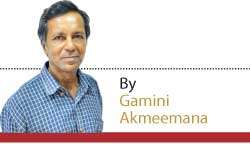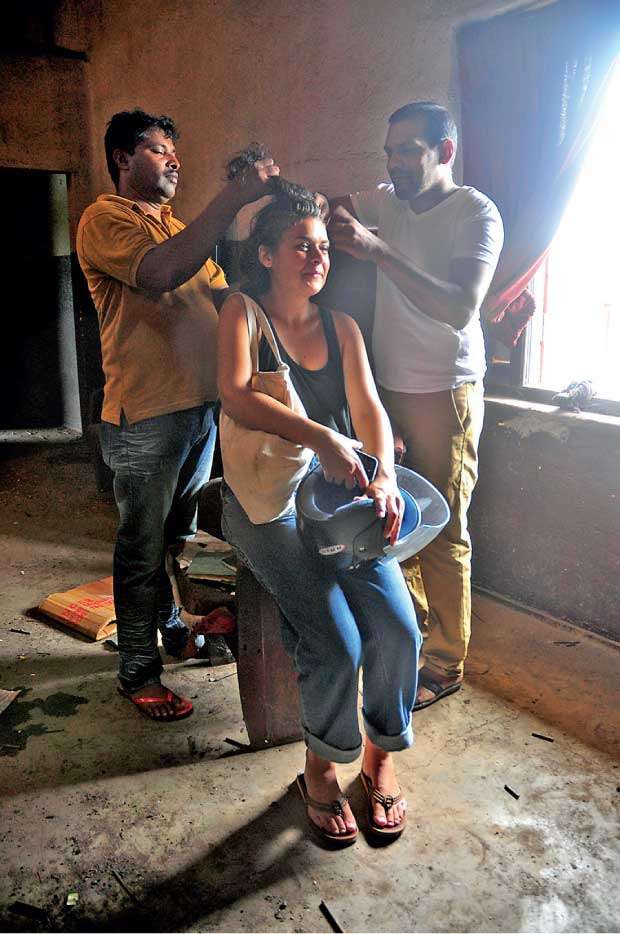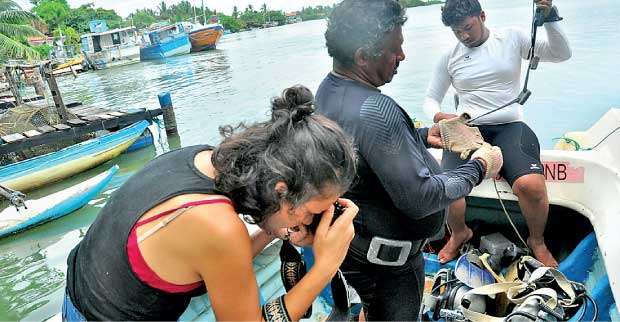Reply To:
Name - Reply Comment
Last Updated : 2024-04-17 10:39:00

This turned out to be one of the zaniest stories ever to come my way. But it wasn’t supposed to be my story at all. I was accompanying French photojournalist Kenia Sadoun to Negombo. She was keen on doing a photo feature about Namal Fernando who dives for mussels in the Negombo lagoon.
 She is from Lyon, France, has a bachelor’s degree in visual arts, and she is part of a photographers’ co-operative with six permanent members. They all work with analog photographic technology, meaning negative film and old film cameras. Kenia Sadoun uses an Olympus OM4 SLR, a camera which began its life in 1983 (the series ended production in 2002). She travels with a backpack and prefers this camera because it feels very lightweight for a SLR of that time.
She is from Lyon, France, has a bachelor’s degree in visual arts, and she is part of a photographers’ co-operative with six permanent members. They all work with analog photographic technology, meaning negative film and old film cameras. Kenia Sadoun uses an Olympus OM4 SLR, a camera which began its life in 1983 (the series ended production in 2002). She travels with a backpack and prefers this camera because it feels very lightweight for a SLR of that time.
She uses a Canon point-and-shoot autofocus camera as back up. It was fascinating to see someone so young using this analog technology of a kind that I grew up with long ago. It was like time travel. She says that in France negative film photography is making a comeback, with colour labs now operating in many cities, and more and more young photographers are buying once-discarded film cameras. Kenya Sadoun develops and prints black and white. Several types of film are available; but since film is expensive, she buys cans of b & w Orwo negative film in 100 ft cans, loading them into cassettes in her dark room, though she had loaded her camera with Kodak T-Max 400 b & w film for this assignment.
Her attitude is in stark contrast to the digital madness in Sri Lanka, where there are no more labs processing colour films as far as I know, and the only lab processing and printing black and white in Colombo has ceased that operation
That takes me back to the 1980s when we used to load discarded film cassettes with cans of Orwo 80ASA made in East Germany, imported by Dilfilms. Dilman Jayaratne was the agent for Orwo in Sri Lanka. Orwo became unavailable to us soon after the two Germanies were re-united.
Her attitude is in stark contrast to the digital madness in Sri Lanka, where there are no more labs processing colour films as far as I know, and the only lab processing and printing black and white in Colombo has ceased that operation. People think that analog photography is dead, but happily that is not the case in Europe.
Though she would love to work as a photo editor, competition is fierce and she has not yet found a place. But she has started working now as a professional photographer, determined to make it. She arrived in Sri Lanka a month ago to teach photography as a volunteer in a project in Mahavilachchiya. With that assignment done, she was now in Negombo to get her photo feature done before leaving. After looking at possible story lines, she chose the mussel culture story.

Namal Fernando lives by the lagoon and swears by it. He is a man of many parts – activist, environmentalist, diver and story teller. He is the first to introduce mussel culture in to the Negombo lagoon. He and his son Visal Alex Nimrod dive once or twice a week to collect each week’s harvest. It is hard work, as they spend anything up to one hour collecting them, until the oxygen in their tanks is nearly exhausted.
She takes pictures sparingly, not clicking away like digital photographers do. This is typical of film photographers, unless they work for international agencies where the budget allows any number of film rolls per assignment, or sports photographers equipped with motor driven cameras.
But the zaniest part happened as we were on our way to the lagoon. Passing Negombo town, I saw the now disused Regal cinema and asked Kenia if she would like to visit it, as she had studied cinema. We walked in to be greeted by two young men -- Kamal the manager, and Kumar, his assistant.
The Regal, owned by Ceylon Theatres, has been closed for some time. The auditorium still has those familiar wooden chairs with curving backs. We went to the projection room upstairs. Its equipment has been removed and the floor was dusty and filled with bits of old film reels and other debris.
I began talking to Kumar about the history of the Regal, and saw Kenia Sadoun sitting in the one dusty old chair remaining in the room. It was a bit unreal at first, rather like the start of a movie. It took a moment to realise that Kamal was doing something to the photojournalist’s hair. Suddenly, he called Kumar to hold a strand of her hair and assist him.

She was getting her hair braided, and free of charge, too. It was so zany I began laughing. Sometimes, the best stories simply happen, out of the blue. Inside that abandoned projection room, mostly dark except for a weak electric bulb and daylight coming in through a single window, the sitter, the hairdresser and his assistant looked like a setting for a chiaroscuro painting. Or, more likely, perhaps the zaniest scene to unfold inside that venerable projection room from 1928 to the date this cinema closed. I have heard that culture gaps wider than any ocean can be bridged by language, kindness, romance – and here was proof before my eyes that they can be bridged in a flash by hairdressers, too.
That’s how I stumbled upon one of the craziest stories in my working life.

Add comment
Comments will be edited (grammar, spelling and slang) and authorized at the discretion of Daily Mirror online. The website also has the right not to publish selected comments.
Reply To:
Name - Reply Comment
On March 26, a couple arriving from Thailand was arrested with 88 live animal
According to villagers from Naula-Moragolla out of 105 families 80 can afford
Is the situation in Sri Lanka so grim that locals harbour hope that they coul
A recent post on social media revealed that three purple-faced langurs near t

10 Apr 2024
09 Apr 2024